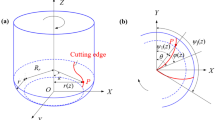Abstract
In the process of the five-axis milling process, due to the changing of the cutter-workpiece engagement area and instantaneous uncut chip thickness, five-axis milling forces prediction is difficult compared with three-axis forces prediction. This study proposed a new analytical method to predict milling force in five-axis milling. Compared with the mechanistic calibration method and experiment method, this method predicts the cutting force accurately, does not need experiments, and only needs to know the input parameters, such as tool parameters, workpiece parameters, and cutting conditions. The effect of lead angle and tilt angle is analyzed by theoretical simulation. The correctness of the prediction model is verified by experiments under different conditions.









Similar content being viewed by others
References
Arrazola PJ, Özel T, Umbrello D, Davies M, Jawahir IS (2013) Recent advances in modelling of metal machining processes. CIRP Ann Manuf Technol 62:695–718
Altintas Y, Kersting P, Biermann D, Budak E, Denkena B, Lazoglu I (2014) Virtual process systems for part machining operations. CIRP Ann Manuf Technol 63(2):585–605
Tunc LT, Budak E (2009) Extraction of 5-axis milling conditions from CAM data for process simulation. Int J Adv Manuf Technol 43:538–550
Zhu R, Kapoor SG, DeVor RE (2001) Mechanistic modeling of the ball end milling process for five-axis machining of free-form surfaces. J Manuf Sci Eng 123(3):369–379
Sun Y, Guo Q (2011) Numerical simulation and prediction of cutting forces in five-axis milling processes with cutter run-out. Int J Mach Tools Manuf 51:806–815
Li Z-L, Jin-Bo X-ZN, Wang L-MZ (2015) Mechanistic modeling of five-axis machining with a general end mill considering cutter runout. Int J Mach Tools Manuf 96:67–79
Zhu Z, Yan R, Peng F, Duan X, Zhou L, Song K, Guo C (2016) Parametric chip thickness model based cutting forces estimation considering cutter runout of five-axis general end milling. Int J Mach Tools Manuf 101:35–51
Duan X, Peng F, Yan R, Zhu Z, Huang K, Li B (2016) Estimation of cutter deflection based on study of cutting force and static flexibility. J Manuf Sci Eng 138(4):041001
Guo M, Wei Z, Wang M (2018) An identification model of cutting force coefficients for five-axis ball-end milling. Int J Adv Manuf Technol 99:937–949
Gdula M, Burek J, Zylka L, Plodzien M (2018) Five-axis milling of sculptured surfaces of the turbine blade. Aircr Eng Aerosp Technol 90(1):146–157
Ghorbani M, Movahhedy MR (2019) Extraction of surface curvatures from tool path data and prediction of cutting forces in the finish milling of sculptured surfaces. J Manuf Process 45:273–289
Lin Z, Deng B, Peng F et al (2020) Semi-analytic modelling of cutting forces in micro ball-end milling of NAK80 steel with wear-varying cutting edge and associated nonlinear process characteristics. Int J Mech Sci 169:105343. https://doi.org/10.1016/j.ijmecsci.2019.105343
Budak E, Altintas Y, Armarego EJA (1996) Prediction of milling force coefficients from orthogonal cutting data. J Manuf Sci Eng 118:216–224
Fontaine M, Devillez A, Moufki A, Dudzinski D (2006) Predictive force model for ball-end milling and experimental validation with a wavelike form machining test. Int J Mach Tools Manuf 46:367–380
Fu Z, Yang W, Wang X, Leopold J (2016) An analytical force model for ball-end milling based on a predictive machining theory considering cutter runout. Int J Adv Manuf Technol 84:2449–2460
Zhou R, Yang W, Yang K (2016) Force prediction models for helical end milling of nickel-aluminum bronze. Int J Adv Manuf Technol 86:1487–1498
Zhou R, Yang W (2019) Analytical modeling of machining-induced residual stresses in milling of complex surface. Int J Adv Manuf Technol 105:565–577
Funding
This study is supported by the Major State Basic Research Development Program of China (973 Program, Grant No.2014CB046704) and the Starting Research Fund from the Hubei University of Arts and Science.
Author information
Authors and Affiliations
Corresponding author
Additional information
Publisher’s note
Springer Nature remains neutral with regard to jurisdictional claims in published maps and institutional affiliations.
Rights and permissions
About this article
Cite this article
Zhou, R. Analytical model of milling forces prediction in five-axis milling process. Int J Adv Manuf Technol 108, 3045–3054 (2020). https://doi.org/10.1007/s00170-020-05582-6
Received:
Accepted:
Published:
Issue Date:
DOI: https://doi.org/10.1007/s00170-020-05582-6




